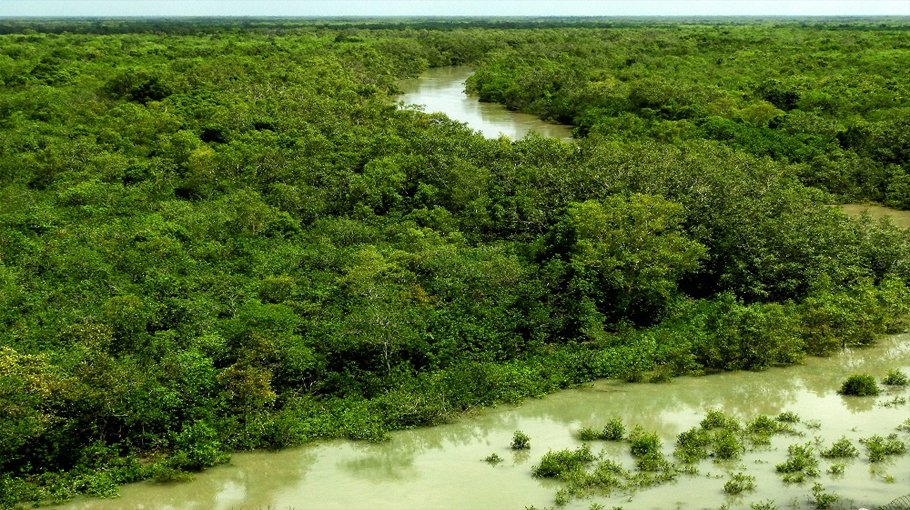Sundarbans landmass shrinking

Landmass of the Sundarbans, the largest mangrove forest in the world encompassing a total area of about 11,000 square km, is shrinking year by year due to various factors including encroachment, pollution and impacts of climate change.
Alongside the decrease of landmass, the environment and biodiversity of the mangrove forest are also under threat for the indiscriminate tree cutting, fishing with poison, lack of awareness and indifference of the authorities.
Howladar Azad Kabir, officer-in-charge of Sundarbans Karamjal Tourism and Wildlife Breeding Centre said that the major threat to Sundarbans is climate change and violence against the mangrove forest by a section of people.
“Once the forest trees were cut, now it is not done, but the Sundarbans is now being damaged due to fishing with poison. If this continues, there will be no Sundarbans. So, together we have to save the Sundarbans in the interest of Bangladesh,” said the Sundarbans official.
He, however, said that various steps are being taken by the Department of Forest to protect the Sundarbans and its biodiversity.
According to different reports, the landmass of Sundarbans has shrunk by about 500 square kilometers in the last 100 years.
According to a World Bank report published in 2020, the total area of Sundarbans was 11,904 square kilometers in 1904-24. In 1967, it decreased to 11,663 square kilometers. In 2015-16, the area was 11, 506 square kilometers. The landmass of Sundarbans is now more narrowed.
The main reason behind shrinking of the Sundarbans landmass is the surrounding sea level, which is rising more than twice as fast as the global average, said geologists.
Satellite imagery, however, shows that the sea level has risen in the Sundarbans by an average of three centimetres a year over the past twenty years, and the area has lost almost 12 percent of its shoreline in the last forty years.
Alongside the sea level rise, a gradual reduction in sediment flow from rivers to the Sundarbans region has resulted in loss of landmass.
According to some experts, river erosion is also another reason for the shrinking landmass of Sundarbans. There are numerous rivers and canals in the Sundarbans. The total length of these canals and rivers is about 350 km. The rivers and canals are filled with tide water twice a day, and water recedes twice at low tide. Due to tides, the banks of the river break and build again. But it has been seen in 100 years, the erosion is more. Which could not be prevented even today.
Due to these factors, some islands have already been submerged and it is predicted that many more will vanish if sea level rise maintains its current pace.
Talking to Bangladesh Post, Sharif Jamil, general secretary of Bangladesh Poribesh Andolon (BAPA) said that people are constantly occupying the Sundarbans and building houses and bazaars. The Sundarbans is shrinking also because of the rise in sea level due to climate change.
About protection, he said that the government has to adopt a zero-tolerance policy to protect the Sundarbans. At the same time, forest protection and law enforcement forces should be stricter in preventing people from entering the Sundarbans.
On the other hand, the environment and biodiversity of Sundarbans are under a serious threat. There were 400 species of birds that used to inhabit there. The number has now come down to 270. On the other hand, the latest camera survey of 2018 found 114 tigers in the Sundarbans.
Experts, geologists and environmentalists said that the environment and biodiversity of Sundarbans are getting damaged due to decrease in size and pollution. Plants and animals are decreasing there. The Sundarbans is also getting weaker amid various adversities. The Sundarbans must be saved. If it is lost, the existence of Bangladesh will be threatened, they said.
Muhammad Anowarul Hoque, secretary general at Save Our Sea, told Bangladesh Post that Sundarbans is constantly protecting Bangladesh from various devastating natural disasters, including cyclones. There is no alternative to save it, and if the Sundarbans does not survive, Bangladesh will not survive. Alongside the environmental and ecological importance, the beauty of Sundarbans and its biodiversity attract tourists, he added.
Talking on the issue, Prof Dr Kamruzzaman Majumder, founding chairman of Center for Atmospheric Pollution Studies (CAPS) highlighted the ecological importance of Sundarbans, mentioning that Sundarbans is the oxygen reservoir of Bangladesh.
He said that the Sundarbans plays a vital role in controlling air pollution in the country. Air pollution is being eliminated through the Sundarbans and the air purification opportunities are also created, he added.
Not only from the environmental and ecological aspects, the Sundarbans is also an indispensable part of the livelihood of the marginal people of coastal areas. Many people of coastal communities extract honey, betel leaves, fish and crabs from there.
The Sundarbans were declared a reserve forest before the partition of India in 1875. UNESCO
declared the Indian and Bangladesh portions of the Sundarbans as World Heritage Sites in 1987 and 1997 respectively. The mangrove forest is also recognised under the Ramsar Convention on Wetlands.


